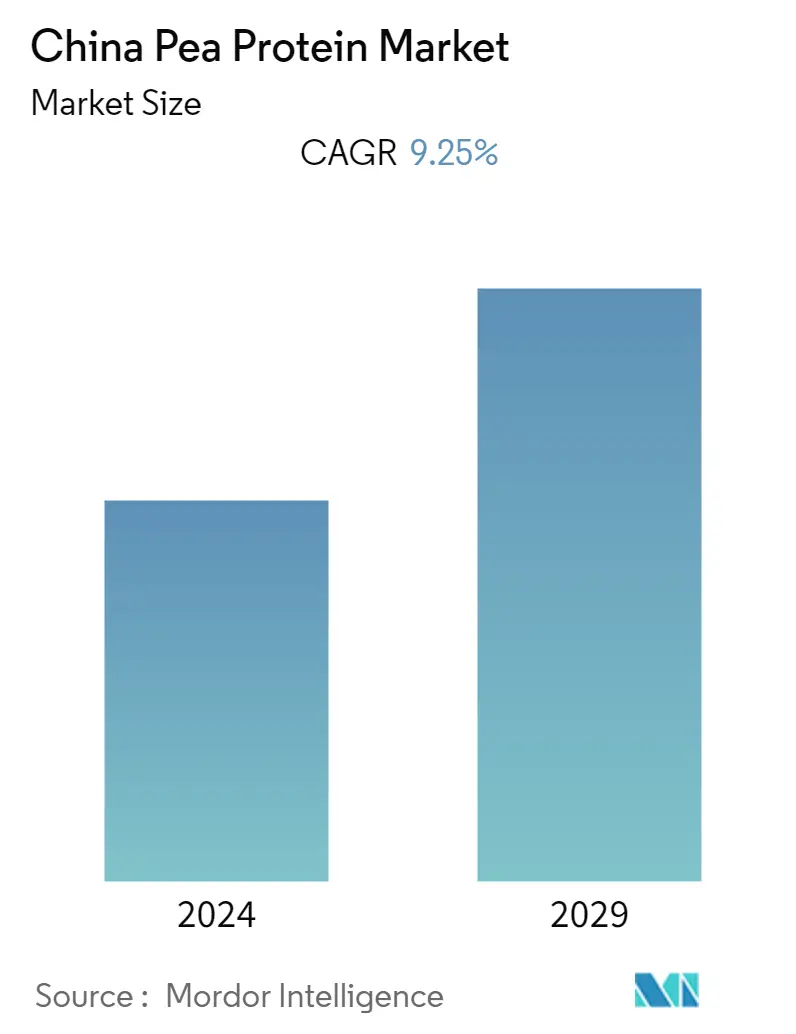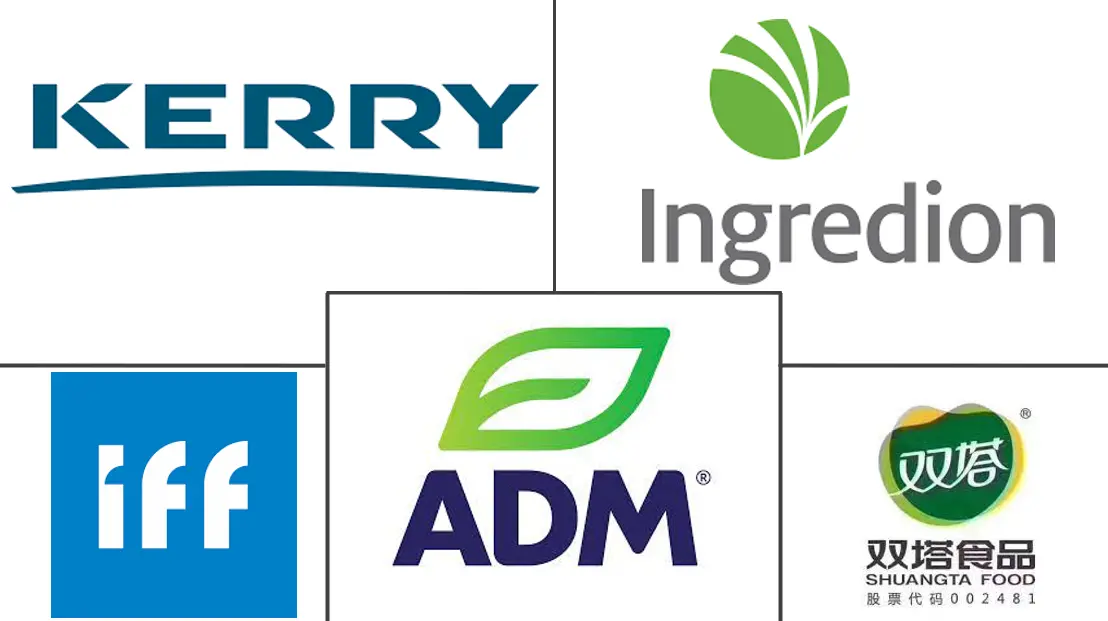Market Size of China Pea Protein Industry

| Study Period | 2019 - 2029 |
| Base Year For Estimation | 2023 |
| Forecast Data Period | 2024 - 2029 |
| Historical Data Period | 2019 - 2022 |
| CAGR | 9.25 % |
| Market Concentration | Low |
Major Players
*Disclaimer: Major Players sorted in no particular order |
China Pea Protein Market Analysis
The China pea protein market size is expected to grow from USD 152.42 million in 2023 to USD 237.25 million by 2028, at a CAGR of 9.25% during the forecast period (2023-2028).
- The increasing lactose-intolerant population in the country, coupled with the rise in the demand for plant-based products owing to their nutritional benefits, low cholesterol, and alternative to meat products, are driving the market's growth in the country. Lactose intolerance is 'an impaired ability to digest lactose, a sugar found in milk and other dairy products, and according to ProCon.org, in 2022, 85% of China's population is lactose intolerant.
- Additionally, due to sustainability concerns and social reasons, the majority of the population in China is vegetarian, vegan, or flexitarian, which is raising the market's demand. This has eventually raised the popularity of plant-based foods and gluten-free products and the nutritional benefits of pea-based products in the country.
- Moreover, owing to the growing number of customers who are concerned about their health, the demand for products with clean-label ingredients, without synthetic ingredients and genetically modified organisms (GMOs), is rising. In line with this, pea protein gains an advantage here, and consumers find it intriguing because it is natural and has non-GMO properties.
- Furthermore, with major players in the country offering pea protein ingredients with multiple application capabilities and functional properties, manufacturers are attracted to incorporate such ingredients into their products to gain the upper hand in the market. Eventually, consumers are also inclined toward such clean-label products.
- For instance, Cargill. Inc. offers RadipureTM, a pea protein claimed to be developed and manufactured for Asian markets, including China. Radipure™ pea protein offers the solubility and flavor profile that customers need for food application development. The company claims that Radipure pea protein has label-friendly, low-allergenic, and non-GMO features and is a highly versatile ingredient that can be used in dairy, ready-to-drink beverages, bakery, and meat alternatives. Such factors are further expected to boost the market's growth during the forecast period.
China Pea Protein Industry Segmentation
Pea protein is a food product and protein supplement derived and extracted from yellow and green split peas, Pisum sativum.
The China pea protein market is segmented by form and end-user. Based on form, the market is segmented into protein concentrates, isolates, and textured/hydrolyzed protein. Based on application, the market is segmented into animal feed, personal care and cosmetics, food and beverages, and supplements. The food and beverage segment is further sub-segmented into the bakery, beverages, breakfast cereals, condiments/sauces, confectionery, dairy and dairy alternative products, meat/poultry/seafood and meat alternative products, RTE/RTC food products, and snacks. Similarly, the supplements segment is also sub-segmented into baby food and infant formula, elderly nutrition and medical nutrition, and sport/performance nutrition.
The market sizing has been done in value terms in USD and for volume terms in volume in tons for all the abovementioned segments.
| Form | |
| Concentrates | |
| Isolates | |
| Textured/Hydrolyzed |
| End-User | |||||||||||
| Animal Feed | |||||||||||
| Personal Care and Cosmetics | |||||||||||
| |||||||||||
|
China Pea Protein Market Size Summary
The China pea protein market is experiencing significant growth, driven by a shift in consumer preferences from animal-based to plant-based proteins. This transition is largely influenced by the increasing lactose-intolerant population and the rising demand for plant-based products due to their nutritional benefits and low cholesterol content. The growing popularity of vegan, vegetarian, and flexitarian diets, fueled by sustainability concerns and health consciousness, is further propelling the market. Pea protein, with its clean-label and non-GMO properties, is gaining traction as a natural alternative to meat products, appealing to health-conscious consumers seeking products without synthetic ingredients. Major players in the market are capitalizing on this trend by offering pea protein ingredients with versatile applications and functional properties, enhancing their appeal in various food and beverage sectors.
The demand for pea protein in China is also bolstered by its functional attributes, such as solubility and emulsion ability, making it a valuable ingredient in the food industry. Its application in snacks, baby foods, and as a meat alternative is driving its popularity among manufacturers. The increased production of peas within the country supports the availability of high-quality ingredients, attracting more businesses to the market. The fragmented nature of the market sees both national and international players, such as Archer Daniels Midland Company and Ingredion Incorporated, actively engaging in mergers, acquisitions, and research to innovate and expand their product offerings. This competitive landscape, combined with the rising imports of peas, underscores the growing demand for pea protein in China, positioning it as a promising sector within the plant-based food industry.
China Pea Protein Market Size - Table of Contents
-
1. MARKET DYNAMICS
-
1.1 Market Drivers
-
1.1.1 Growing Inclination Towards Plant-Based Protein Sources
-
1.1.2 Rising Application Capabilities of Pea Protein
-
-
1.2 Market Restraints
-
1.2.1 Rising Popularity and Availability of Other Plant-based Proteins
-
-
1.3 Industry Attractiveness - Porter's Five Forces Analysis
-
1.3.1 Bargaining Power of Suppliers
-
1.3.2 Bargaining Power of Buyers
-
1.3.3 Threat of New Entrants
-
1.3.4 Threat of Substitute Products and Services
-
1.3.5 Intensity of Competitive Rivalry
-
-
-
2. Market Segmentation
-
2.1 Form
-
2.1.1 Concentrates
-
2.1.2 Isolates
-
2.1.3 Textured/Hydrolyzed
-
-
2.2 End-User
-
2.2.1 Animal Feed
-
2.2.2 Personal Care and Cosmetics
-
2.2.3 Food and Beverages
-
2.2.3.1 Bakery
-
2.2.3.2 Beverages
-
2.2.3.3 Breakfast Cereals
-
2.2.3.4 Condiments/Sauces
-
2.2.3.5 Confectionery
-
2.2.3.6 Dairy and Dairy Alternative Products
-
2.2.3.7 Meat/Poultry/Seafood and Meat Alternative Products
-
2.2.3.8 RTE/RTC Food Products
-
2.2.3.9 Snacks
-
-
2.2.4 Supplements
-
2.2.4.1 Baby Food and Infant Formula
-
2.2.4.2 Elderly Nutrition and Medical Nutrition
-
2.2.4.3 Sport/Performance Nutrition
-
-
-
China Pea Protein Market Size FAQs
What is the current China Pea Protein Market size?
The China Pea Protein Market is projected to register a CAGR of 9.25% during the forecast period (2024-2029)
Who are the key players in China Pea Protein Market?
Archer Daniels Midland Company, Ingredion Incorporated, Kerry Group PLC, Yantai Shuangta Food Co. Ltd and International Flavours & Fragrances Inc. are the major companies operating in the China Pea Protein Market.

